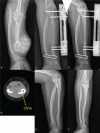Identification of risk factors affecting bone formation in gradual ulnar lengthening in children with hereditary multiple exostoses: A retrospective study
- PMID: 30702592
- PMCID: PMC6380801
- DOI: 10.1097/MD.0000000000014280
Identification of risk factors affecting bone formation in gradual ulnar lengthening in children with hereditary multiple exostoses: A retrospective study
Abstract
The forearm deformity classified by Masada is a characteristic trait of patients with hereditary multiple exostoses (HME). Ulnar gradual lengthening, which was considered to be a safe and reliable procedure, was popular in treating these difficult deformities, however, delayed consolidation of the callus is uncommon but not rare in literature review. The purpose of this study was to try to identify the risk factors influencing bone healing in gradual ulnar lengthening in HME.We retrospectively reviewed patients with HME-induced forearm deformity who underwent gradual ulnar lengthening at our hospital from 2010 to 2016. Patients' demographic data, forearm deformity of Masada type, surgical procedure, ulnar diameter of osteotomy site, and external fixator type were recorded. We also reviewed radiographical data included gained length, axis deviation, callus form. Clinical outcome was assessed by the bone healing index (HI). Multiple linear regression was used to analyze the relationships between diffident parameters and the HI, the level of significance was set P <.05.Thirty-three patients were included in this study. The mean follow-up period was 1.5 (range 0.5-8) years. Circular external fixators were used in 5 patients and monolateral external fixators were used in 28 patients. The mean achieved length was 4.24 cm. The mean HI was 50.3 (range 26.6-99.3) days/cm. In patient with monolateral external fixator, patient's age was positively correlated with the bone HI (P = .001), while diameter and body mass index (BMI) were negatively correlated with the HI (P = .040, .018, respectively). Patient's sex, removal of distal ulnar exostoses, lengthening percentage, and axis deviation were non-significant in the regression model.When using monolateral external fixator for ulnar lengthening, patient's age, diameter of osteotomy site, and BMI are the most important risk factors related to bone formation. Pediatric orthopedic surgeons should consider these variables in order to avoid delayed union.
Conflict of interest statement
The authors have no conflicts of interest to disclose.
Figures



References
-
- Solomon Hereditary multiple exostosis. J Bone Jt Surg Br Vol 1963;45:292–304.
-
- Clement ND, Porter DE. Forearm deformity in patients with hereditary multiple exostoses: factors associated with range of motion and radial head dislocation. J Bone Jt Surg Am Vol 2013;95:1586–92. - PubMed
-
- Masada K, Tsuyuguchi Y, Kawai H, et al. Operations for forearm deformity caused by multiple osteochondromas. J Bone Jt Surg Br Vol 1989;71:24–9. - PubMed
-
- Akita S, Murase T, Yonenobu K, et al. Long-term results of surgery for forearm deformities in patients with multiple cartilaginous exostoses. J Bone Jt Surg Am Vol 2007;89:1993–9. - PubMed
Publication types
MeSH terms
LinkOut - more resources
Full Text Sources

